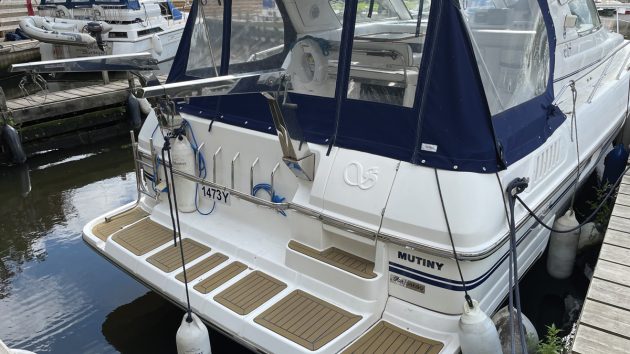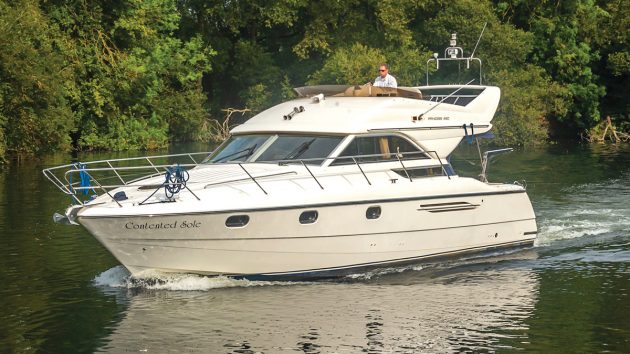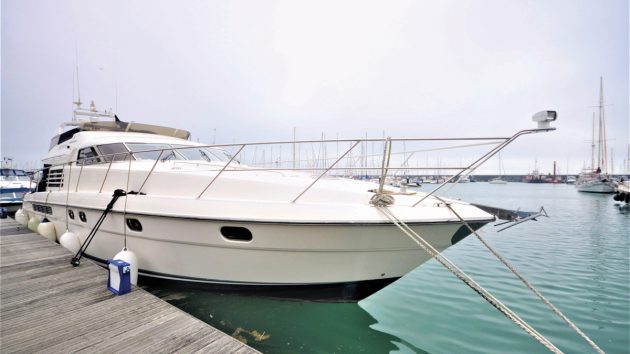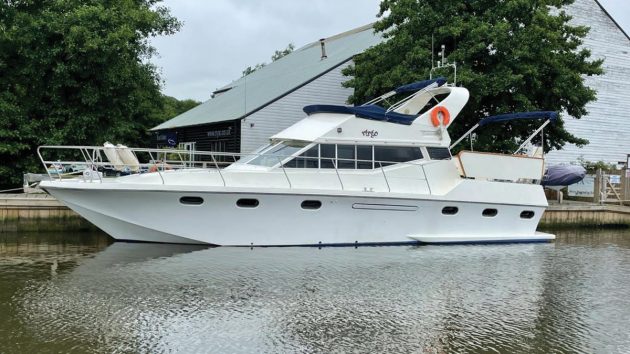Our resident used boat expert Nick Burnham picks out four of the best boats from the 1990s that can be found for less than £200,000.
How old does a boat have to be before we can call it a classic? In the horological world, watches over 25 years old are generally reckoned to be vintage, although that doesn’t necessarily qualify them as classics – only the best get that accolade.
With cars it seems anything elderly (even an old Ford Escort) is automatically a classic, and while most of us think of ‘60s icons like the E-Type Jaguar or Ferrari 250 GTO as the archetypal classic cars, few people would argue against a Lotus Carlton (built between 1990 and 1992) being dubbed a classic.
With boats it gets even more ethereal, and scary – we are, after all, talking about vessels that I was selling brand new, back in the day!
So I hope you’ll agree that these ‘90s vessels are all ‘classics’, and not our esteemed editor’s alternative (and unprintable) title when I first mooted them.

Sealine 365
Built: 1991
Price: £62,950
What do the Austin Metro and the Sealine 365 have in common? It sounds like a joke, but it’s a serious question. Both were designed by Roger Tucker.
Sealine drafted him in to update its line-up, and the 365 introduced a far curvier shape than was traditional, plus the dolphin nose that hid the anchor. But the most distinctive structural element was the T-bar structure over the forward section of cockpit.

Interior
The Sealine 365 sported acres of space down below. It put contemporaries like Princess’s 36 Riviera to shame.
Two things played to the 365’s advantage: sterndrive engines (compared to the traditional shaft drive of the Princess); and a raised sportsbridge helm position that vastly increased headroom in the cabin beneath it, plus three beds and a private ensuite, unheard of in a sub 40ft sportscruiser.
The combined saloon and galley are huge, and there’s a forward cabin with offset double berth and another heads.

Raised sportsbridge helm offers commanding view and frees up space below
Exterior
The larger the sportscruiser, the larger the cockpit and therefore the larger the canopies to fight into submission. The Sealine’s centre T-bar means that the canopy is split into three more manageable sections instead of the usual two. And the cockpit on the 365 is enormous!
The raised forward section of the sportsbridge seats seven, while customer demand saw an L-shaped seat added to the lower aft section too.
Performance
Volume and sterndrive engines pay dividends for space, but not performance. When introduced, the largest Volvo Penta sterndrive diesel engine was 200hp and top speed was an adequate but unsporty 26 knots.
Sealine countered this by offering a triple installation, lifting the top speed to 33 knots. However, the extra cost, weight and complexity meant that only ten were built with triples. A better solution is the twin KAD 44 EDC 260hp engines fitted to this boat.

Tardis-like interior includes very roomy saloon and galley
Seakeeping
A solid performer, the Sealine 365 suffers for its height and bulk combined with outdrives (which exert less leverage than shafts as the propellers are further aft) during close-quarters manoeuvres. A bow thruster makes for a powerful ally.
Specifications
Length: 40ft 0in (12.2m)
Beam: 13ft 0in (4.0m)
Draught: 2ft 11in (0.9m)
Displacement: 7.5 tonnes
Fuel capacity: 727 litres
Engines: Twin 260hp Volvo Penta KAD 44 diesel engines
Location: Norfolk
Contact: Norfolk Yacht Agency

Princess 420
Built: 1996
Price: £148,500
The Princess 420 was another example of a gentle softening of the lines compared with the squared off profiles of earlier models.
Introduced at the 1994 Southampton Boat Show, it replaced the Princess 410 and was an all-new model rather than an evolution of an earlier incarnation (the 410 was a cosmetic upgrade of the 398, itself a Princess 388 with an integral bathing platform).

Interior
The layout virtually mirrored the Princess 410 (if it ain’t broke) with an ensuite owner’s cabin forward, guest cabin and day heads to starboard (usefully linked to give two ensuite cabins) and galley to port on the lower deck, inside helm and saloon on the main deck.
But the finish was quite different. The most obvious change was to the woodwork. Gone was the grained pear of the older boat, replaced with a high gloss burr maple, which Princess Yachts referred to as a ‘superyacht finish’.

Helm can join the party in the saloon where the claimed ‘superyacht finish’ is evident
Exterior
There were quite a few changes on the exterior. Beneath the waterline, chine flats were toed in for extra spray deflection. Above the waterline, improvements were more obvious.
The flybridge overhang was significantly increased, giving more shelter to the cockpit and more space up top, with a side benefit of vertical cockpit canopies without needing any framework to support them.
Finally, the ladder to the flybridge of the previous model makes way for proper steps, which are much easier to climb.

Ensuite owner’s cabin looks classy and light thanks to burr maple
Performance
Most 420s went out with a pair of Volvo Penta TAMD 63P 370hp diesels utilising shaft drive. Slightly less powerful Caterpillar 3116TA engines at 355hp a side were also available for anyone with an aversion to green.
We achieved 29 knots when we tested the boat with the former, with 2,400rpm giving the most economical planing speed at 22.7 knots and 78 litres per hour.
Seakeeping
In a lull between December storms in seas big enough to hide the photo boat, “The boat was very well behaved, you just point it, add a touch of trim as required and enjoy the ride.”
Specification
Length: 41ft 9in (12.7m)
Beam: 13ft 8in (4.2m)
Draught: 3ft 3in (1.0m)
Displacement: 10.5 tonnes
Fuel capacity: 1,360 litres
Engines: Twin Volvo Penta TAMD 63P diesel engines
Location: River Thames
Contact: Tingdene Boat Sales

Fairline Squadron 59
Built: 1996
Price: £189,000
In a time when it’s possible to spend well over £100,000 on a trailerable cuddy cabin sportsboat with an outboard engine, a few thousand more for a bona fide British-built high quality twin diesel mini-superyacht seems incredible value.
At 25 years old, it’s a long way from the cutting edge of modernity, but there’s no denying that it has style, presence and, above all, space.

Interior
In 1996, full beam midship owner cabins weren’t yet a thing, but 60ft of LOA gives plenty of volume. So you’ll find a generous master cabin in the bow, ensuite of course (there’s even a bidet, something you rarely see these days) and then a further two guest cabins slightly aft on the lower deck that share the day heads.
Step up to the main deck and you’ll find a generous semi-circular dinette alongside the double helm – great for both dining and joining the skipper and navigator on a cruise.
The galley is to starboard behind the helm with the saloon aft of it, featuring another big semi-circular sweep of seating opposite a sideboard. A feast of high gloss cherry and cream leather, it’s of its age, yet warm and inviting.

Saloon with sweep of comfortable seating is a place of style and charm
Exterior
There’s no mistaking this for a current era vessel, but it’s not without its charm.
The curved stainless steel windscreen has an almost aircraft fuselage vibe to its extravagantly curved stainless steel-framed windscreen and the ‘Testarossa’ slats across the saloon side windows are distinctive and stylish.
There’s useful stair access from the forward end of the main deck to the front of the flybridge.

Sociable semi-circular dinette is adjacent to the helm and galley
Performance
Fairline offered twin MAN 680hp diesels or the twin Volvo Penta TAMD122 600hp diesels fitted to this example. Top speed is in the high 20 knot region, with 22 knots a comfortable cruising gait.
Seakeeping
With a Bernard Olesinski hull and shaft drive, you can’t go wrong. Add the inevitably long waterline length of a 60ft vessel and over 20 tonnes of displacement and you’ve got a seriously capable offshore cruiser.
Specifications
Length: 59ft 0in (18.0m)
Beam: 15ft 5in (4.7m)
Draught: 3ft 10in (1.2m)
Displacement: 22 tonnes
Fuel capacity: 1,000 litres
Engines: Volvo Penta TAMD122 600hp diesel engines
Location: Brighton
Contact: Global Yacht Brokers

Seacoral 425
Built: 1991
Price: £75,000
Seacoral came into existence entirely by accident. It began with the collapse of a small boatbuilding company back in 1984.
As a result, the Barline Group of leisure and entertainment companies acquired the moulds of a modified Powles 38 (a boat designed by Bernard Olesinski, who went on to design every Princess boat from 1989 onwards).
Standard practice might have been to sell the mould to a boatbuilder, and maybe they tried that. But for whatever reason, Barline set up a subsidiary company, modernised the superstructure and interior and went into the boatbuilding business in collaboration with Bounty Boats of Norfolk.

Interior
An aft cabin layout, the Seacoral has accommodation the full length of the hull. So the owner gets a private suite with shower and toilet split off into two compartments.
There’s a saloon in the centre of the boat with a lower helm and then steps back down to the lower deck with a large dinette opposite the galley, day heads and forward cabin.

Saloon has steps down to owner’s suite aft and galley and guest cabin forward
Exterior
The first version of this boat was launched as the 428 – this is the 425 model which benefits from several cosmetic updates such as a more conventional aft sloping radar arch (the original sloped forward).
There’s actually a fair amount of deck space on the 425, the flybridge is a good size and features back-to-back fore and aft seating plus a further seat at the aft end, and the aft deck has solid coamings and more seating.
On this example there are folding bimini tops over both the flybridge and aft deck.

Lower deck galley is well kitted out and there’s a large dinette and day heads opposite
Performance
This boat is fitted with a pair of Volvo Penta TAMB 61A 306hp diesels, so performance is likely to be similar to the 23 knots we achieved when we tested the very first example, which sported a pair of Sabre 300hp diesel engines.
Seakeeping
The original Powles 38 that this boat is based on had a very ‘broad-shouldered’ hull, good for maximising internal volume, but resulting in a bow up running attitude.
A pronounced downward curve was added to the aft sections of the Seacoral hull to rid the boat of excessive nose-up trim, and flared topsides helped manage spray.
Specifications
Length: 43ft 3in (13.2m)
Beam: 13ft 3in (4.0m)
Draught: 3ft 3in (1.0m)
Displacement: 10 tonnes
Fuel capacity: 1,400 litres
Engines: Twin Volvo Penta TAMD 61A 306hp diesel engines
Location: Norfolk
Contact: Precious Marine
First published in the January 2022 issue of MBY.
If you enjoyed this…
Be first to all the latest boats, gadgets, cruising ideas, buying advice and readers’ adventures with a subscription to Motor Boat & Yachting. Available in both print and digital formats, our monthly magazine will be sent directly to your home or device at a substantial discount to the usual cover price. See our latest offers and save at least 30% off the cover price.











